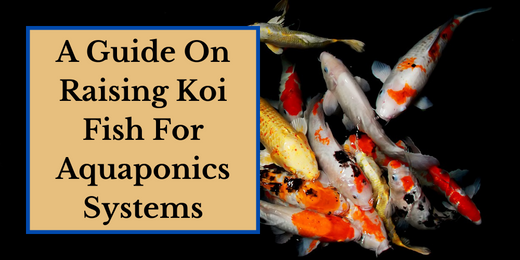If you’ve ever tried growing plants indoors and noticed they looked pale, stretched, or just refused to thrive, the culprit was probably lack of light. In an outdoor aquaponics system, the sun does the heavy lifting. But indoors, without the right grow lights, your plants can’t photosynthesize properly, which means slow growth, poor yields, and frustrated growers.
Light is just as important as water and nutrients in aquaponics. It’s what drives the entire system forward, turning fish waste into leafy greens, herbs, and fruiting plants you can actually enjoy on your plate. Yet, many beginners overlook it, thinking any bulb will do, only to learn the hard way that not all light is created equal.
That’s why this blog is here: to help you understand what kind of grow lights your indoor aquaponics system really needs, how to choose the right type for your setup, and how to avoid the costly mistakes most beginners make.
And here’s the best part: by the end of this article, you’ll not only feel confident in choosing grow lights but also discover how to take your entire aquaponics journey further with this 5-hour Aquaponics Video Course, a step-by-step training that covers everything from light placement to fish care and plant health.
If you’re serious about growing fresh food indoors, this video guide is your starting point and this video course is the shortcut to success.
Do Indoor Aquaponics Systems Really Need Grow Lights?
The short answer: yes, unless your system is right next to a sunny window or greenhouse, you’ll need grow lights.
Here’s why:
1. Natural Sunlight vs. Indoor Reality
Outdoors, the sun provides full-spectrum light for free. Indoors, windows often block parts of the spectrum plants need, and daylight hours can be too short, during winter. That means your plants won’t get the consistency they need to grow strong.
2. Plants Don’t Just Need Light, They Need the Right Light
A regular household bulb might brighten a room, but it won’t give your plants the full spectrum required for photosynthesis. Without enough blue and red light, plants will grow spindly, weak, and produce little to no harvest.
3. Why This Matters for Aquaponics Beginners
Your fish are producing nutrients every day. If your plants can’t use that energy because of poor lighting, you’ll end up with nutrient buildup, unhappy plants, and frustrated results.

How Light Affects Plant Growth in Aquaponics
Light is the engine that drives photosynthesis, the process plants use to turn light into food. In aquaponics, where nutrients come from your fish, light is what enables your plants to actually use those nutrients. Without enough of the right light, your plants won’t thrive no matter how healthy your fish are.
Key Factors of Light in Aquaponics
1. Spectrum:
- Blue light- fuels leafy growth (perfect for lettuces, herbs, leafy greens).
- Red light- supports flowering and fruiting (tomatoes, peppers, strawberries).
- Full-spectrum- balances both, mimicking natural sunlight.
2. Intensity:
Too weak, and your plants stretch toward the light (leggy growth). Too strong, and leaves may scorch or bleach.
3. Duration (Photoperiod):
Most leafy greens need 14–16 hours of light daily, while fruiting plants usually need 12–14 hours.
Quick Reference Table: Light & Plant Growth
|
Light Condition |
What Plants Do |
Signs You’ll See |
|
Too little light |
Slow or no growth |
Pale, yellow leaves; leggy stems |
|
Too much light |
Stress or burn |
Brown leaf tips, dry patches |
|
Wrong spectrum |
Imbalanced growth |
Lots of leaves but no fruit, or vice versa |
|
Balanced light |
Thriving plants |
Vibrant leaves, steady growth, strong yields |
Types of Grow Lights for Aquaponics
Not all grow lights are created equal. Some are affordable and simple, while others provide powerful light for larger or more advanced setups. Below is a breakdown of the most common types you’ll encounter in indoor aquaponics.
1. Fluorescent Lights
Pros:
- Affordable and widely available
- Great for beginners and small leafy green setups
- Low heat output, safe for tight spaces
Cons:
- Limited intensity, not ideal for fruiting plants like tomatoes or peppers
- Shorter lifespan compared to LEDs
2. LED Grow Lights
Pros:
- Energy-efficient, long-lasting (can last 50,000+ hours)
- Customizable spectrum (blue for greens, red for fruiting, or full-spectrum)
- Produce minimal heat, less risk of burning plants
- Available in compact panels or bars for any system size
Cons:
- Higher upfront cost compared to fluorescents
- Quality varies, cheap LEDs often underperform
3. HID (High-Intensity Discharge) Lights
Pros:
- Extremely powerful light output
- Great for large-scale fruiting or flowering crops
- Proven track record in hydroponics/indoor growing
Cons:
- Produce a lot of heat, need extra ventilation and cooling
- Expensive to run (high energy use)
- Bulky compared to LEDs or fluorescents
4. Full-Spectrum Lights
Pros:
- Mimic natural sunlight (covering both blue and red wavelengths)
- Simplifies setup, no need to switch lights for growth vs. fruiting stages
- Excellent for mixed-crop aquaponics systems
Cons:
- Typically more expensive than basic options
- Not all “full-spectrum” labels are accurate, quality matters
What to Look for in a Grow Light
When shopping for a grow light for your aquaponics system, the options can feel overwhelming. Use this simple checklist to narrow down your choices and find the right fit.
Beginner-Friendly Grow Light Checklist
1. Light Spectrum
- Look for full-spectrum lights or those labeled for “plant growth.”
- Blue spectrum = leafy growth, red spectrum = flowering & fruiting.
2. Wattage & Intensity
- Make sure the light is strong enough for your plant type.
- Example: Lettuce and herbs thrive under lower intensity; fruiting crops like tomatoes need stronger light.
3. Coverage Area
- One small panel may be fine for a single grow bed, but larger systems will need multiple lights.
- Check product specs to see how many square feet it covers.
4. Energy Efficiency
- LEDs cost more upfront but save big on electricity bills long term.
5. Heat Output
- Lower-heat lights (like LEDs and fluorescents) are safer and easier to manage indoors.
6. Durability & Lifespan
- LEDs often last 5–10 years. Fluorescents burn out faster and need replacements.
7. Budget
- Fluorescents= lowest upfront cost.
-
LEDs = higher upfront cost, but best long-term value.

Best Practices for Setting Up Grow Lights in Your Aquaponics System
Choosing the right grow light is only half the battle, the real difference comes from how you set it up. Proper placement, timing, and safety will make or break your harvests.
Step 1: Position Your Lights at the Right Height
- Leafy greens (lettuce, herbs): 6–12 inches above the plants.
- Fruiting crops (tomatoes, peppers): 12–24 inches above to prevent burning.
- Adjust as plants grow, keep the distance consistent for even coverage.
Step 2: Angle and Coverage
- Hang lights directly overhead for even growth.
- For larger beds, use multiple panels or bars side by side.
- Avoid shadows — uneven light = uneven growth.
Step 3: Set the Right Photoperiod (Light Schedule)
- Leafy greens: 14–16 hours per day.
- Fruiting/flowering plants: 12–14 hours per day.
- Use a timer, this saves electricity and ensures consistency (plants love routine).
Step 4: Manage Heat and Ventilation
- LEDs = low heat, safer for close placement.
- HID lights = very hot, so add fans or ventilation.
- Always keep cords and fixtures away from splashing water.
Step 5: Safety First
- Use waterproof power strips and surge protectors.
- Hang lights securely (chains or adjustable hangers work best).
- Keep all electrical components above water level.
Our Top Picks for Indoor Aquaponics System Grow Lights
1. Best Overall Grow Lights for Aquaponics Systems - GE Lighting Grow Light LED Flood Light Bulb
Check Price
Our pick for the best overall grow light is the GE BR30. This grow light from GE is ideal for growing flowering or fruiting plants in your indoor aquaponics system. This red and blue light spectrum is suitable for growing fruits and flowers, and because the bulb is an LED floodlight, it doesn't generate much heat and last longer than other bulbs. This grow light has a rating of 4.7 on Amazon.
Pros:
- Great for saving money
- It can fit into most standard lamps.
- Easy to set up
- Have natural light temperature.
Cons:
- Non-dimmable
2. Best Grow Lights for Larger Indoor Aquaponics Systems - Spider Farmer SF4000 LED Grow Light
Check Price
If you have a budget and a larger indoor aquaponics system, this Spider Farmer grow light will work for you. This grow light contains a full spectrum of colors that is great for the full life cycle of your plants. This is also an LED grow light and has a rating of 4.7 out of 5. The light controller also contains a dimming knob that lets you adjust the intensity of the light. It also comes with a five years after-service warranty, which is great when making a large payment.
Pros:
- High-efficiency
- Easy to set up and operate
- Five-year warranty
- Durable
Cons:
- Expensive
3. Best Budget Grow Lights for Indoor Aquaponics Systems - Aceple LED Small Grow Light
Check Price
The Aceple Desk Plant Grow Light is great for aquaponics growers who are looking for grow lights that produce excellent results at an affordable price. This grow light has been tested and proven to help accelerate plant growth. This versatile grow light can be attached to a table, chair, desk, or countertop because of its wide-opening clamp.
Pros:
- Affordable
- Easy to set up
- Adjustable and flexible gooseneck arm
- Energy-saving
Cons:
- Do not come with a timer
- Buls need to be replaced often
4. Best Grow Lights Winter Growing - SANSI Grow Light Bulb
Check Price
One of the best grow lights for winter growing is SANSI Grow Light Bulb. This full spectrum grow light gives your indoor aquaponics plants better growth, health, and production. Sansi grow light bulb has a superior color rendering index (CRI) compared to other grow lights, which results in a more natural light color that resembles the actual sunlight. This helps your plants thrive during the winter months.
Pros:
- Full spectrum grow light
- Produce less heat
- Long-lasting
- Fully insulated lamp, safe and reliable
Cons:
- More expensive than other grow lights
Runner Ups For Best Grow Lights:
1.VIPARSPECTRA 2023 Upgraded LED Grow Lights
Check Price
The VIPARSPECTRA 2023 Upgraded P2000 LED Grow Light is an updated grow light with a new diode layout and daisy chain function that helps ensure uniform light distribution. Depending on your need, the daisy chain function allows you to connect more grow lights to your system. This grow light is equipped with a dimming function, high PAR output, and high energy efficiency for healthy plant growth and greater yield without worrying about energy cost.
Customers rate these grow lights 4.7 out of five stars. Mostly, they love the node spacing and the results they get with their indoor plants. Even those with their first greenhouses see the vast difference these grow lights make for their different plants.
Pros:
- Full spectrum light with superior heat dissipation
- Low energy consumption
- Provides full-spectrum light
- Dimmable
Cons:
- Despite its heat dissipation feature, the grow light still gets hot and may require ventilation in warmer climates.
2. BESTVA 2023 Upgraded LED Grow Light
Check Price
The BESTVA 2023 Upgraded BP 2000 Led Grow Light is one of the best LED lights you can get for your money. It is a reasonably compact grow light that produces incredible light, perfect for flowering or fruiting plants. It is also dimmable and stays cool to the touch despite its brightness.
The drawback of this grow light is that it is not waterproof, so you should watch out for potential leaks. To sum it up, BESTVA 2000W is an excellent product, but it's not perfect but still suits the needs of experienced and novice aquaponics growers. This grow light has a rating of 4.7 on Amazon.
Pros:
- Very affordable
- Excellent cooling system is excellent–even if you keep the lights on 24/7, they won't produce excessive heat that can potentially damage your plants.
- The LED lights cover the full visible light spectrum.
- Cover surfaces up to 8 x 8 inches and retains optimal efficiency.
Cons:
- The product is not waterproof.
- It doesn't support daisy chaining, meaning you cannot chain several consecutive lights with a single plug.
Common Mistakes Beginners Make with Grow Lights and How to Avoid Them
Even with the right grow lights, it’s easy for beginners to make small errors that add up to poor plant growth. Here are the most common mistakes and how you can sidestep them.
Mistake 1: Too Little Light
- Problem:Plants grow tall and spindly with pale leaves (a sign they’re stretching for light).
- Solution: Increase daily light duration (14–16 hours for greens, 12–14 for fruiting plants) and check that your light intensity is adequate.
Mistake 2: Too Much Light
- Problem: Leaves curl, dry, or turn brown at the edges.
- Solution:Raise your lights a few inches higher or shorten the daily light period.
Mistake 3: Wrong Spectrum
- Problem: Lush green leaves but no fruiting, or flowers that don’t set.
- Solution: Use full-spectrum lights or ensure your setup includes both blue and red light coverage.
Mistake 4: Poor Placement
- Problem:Uneven plant growth, some thrive while others lag behind.
- Solution:Ensure even coverage by adjusting height, spacing lights correctly, and avoiding shaded areas.
Mistake 5: Ignoring Electricity Costs
- Problem:Power bills shoot up unexpectedly.
- Solution: Choose energy-efficient LEDs and use timers to avoid waste.
FAQs About Grow Lights for Aquaponics
1. How many hours per day should I run grow lights in an aquaponics system?
Most leafy greens (like lettuce and herbs) need 14–16 hours of light per day, while fruiting plants (like tomatoes and peppers) do best with 12–14 hours. Using a timer makes this easy and consistent.
2. Can I use regular LED bulbs instead of grow lights?
Not really. Regular household LEDs provide brightness for humans, but they lack the specific blue and red wavelengths plants need for photosynthesis. For healthy growth, use grow lights designed for plants.
3. Do different plants in aquaponics need different grow lights?
Yes. Leafy greens thrive under cooler (blue-heavy) light, while fruiting and flowering crops need more red light. If you want an all-around solution, go with full-spectrum grow lights.
4. What’s the best budget grow light for aquaponics beginners?
For small systems or leafy greens, fluorescent T5s or entry-level LED panels are affordable and effective. If you want long-term value, invest in full-spectrum LEDs, they save money on energy and replacements over time.
5. How far should grow lights be from my aquaponics plants?
- Leafy greens:6–12 inches above the plants
- Fruiting plants: 12–24 inches above the plants
Adjust as your plants grow to maintain even light coverage.
Conclusion
In indoor aquaponics, light is not optional, it’s the fuel that powers your plants. The right grow lights ensure your greens are lush, your herbs are flavorful, and your fruiting plants actually produce. Without them, even the healthiest fish and best system setup won’t reach their full potential.
Now you know:
- Why indoor aquaponics systems need grow lights
- How light spectrum, intensity, and duration affect growth
- The pros and cons of different light types
- What to look for before buying
- How to set up lights safely and effectively
- Mistakes to avoid so you don’t waste time or money
But here’s the truth: while this guide gives you the essentials, successful aquaponics is about bringing all the pieces together, fish care, biofilters, plant selection, water quality, and yes, lighting. That’s why so many beginners get stuck even after reading guides like this one.
If you want to skip the trial-and-error and build a system that works from the start, this 5-hour Aquaponics Video Course is your next step. Inside, you’ll get:
- Step-by-step video lessons from real systems
- Clear demonstrations of lighting setups for leafy greens and fruiting crops
- Practical tips on balancing fish, plants, and water chemistry
- Proven methods to avoid beginner mistakes and grow food successfully indoors














Leave a comment (all fields required)